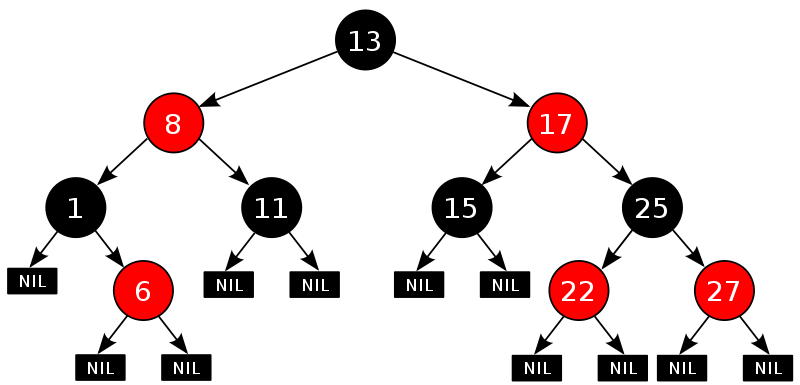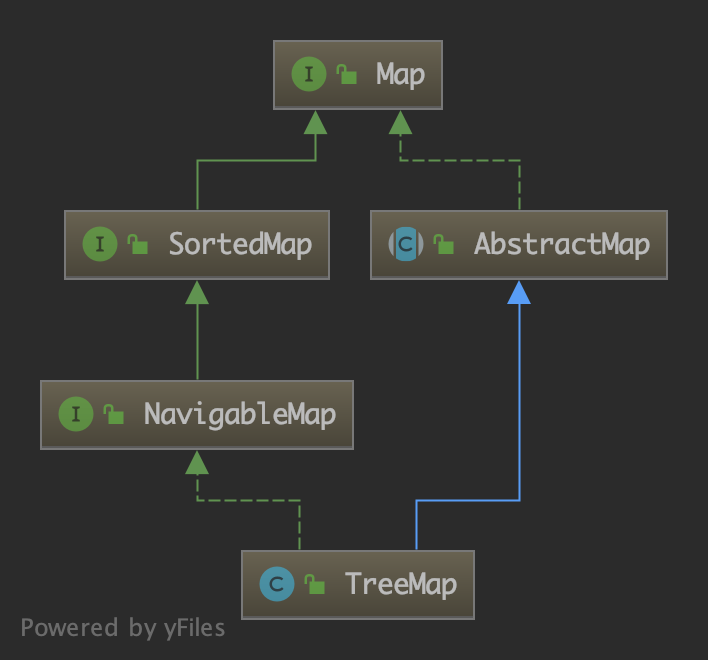【JDK】JDK源码分析-TreeMap(1)
概述
前面数据结构与算法笔记对红黑树进行了分析,而 TreeMap 内部就是基于红黑树实现的。示意图:

它的查找、插入、删除操作的时间复杂度均为 O(logn)。
TreeMap 类的继承结构如下:

类签名:
public class TreeMap<K,V>
extends AbstractMap<K,V>
implements NavigableMap<K,V>, Cloneable, java.io.Serializable
TreeMap 实现了 Map 接口,其内部数据格式是“键-值对”的形式(Entry),排列顺序是按照键的顺序进行的。
代码分析
成员变量
/**
* The comparator used to maintain order in this tree map, or
* null if it uses the natural ordering of its keys.
*
* TreeMap 内部的比较器,若为空,则为自然顺序
*/
private final Comparator<? super K> comparator; // 根节点
private transient Entry<K,V> root; /**
* The number of entries in the tree
*/
private transient int size = 0; /**
* The number of structural modifications to the tree.
*/
private transient int modCount = 0;
构造器
TreeMap 有四个构造器,分别如下:
构造器一:无参构造器
/**
* 无参构造器。使用 key 的自然顺序排列(key 要实现 Comparable 接口)
*/
public TreeMap() {
comparator = null;
}
构造器二:
/**
* 使用指定的 Comparator(比较器)构造一个空的 TreeMap
*/
public TreeMap(Comparator<? super K> comparator) {
this.comparator = comparator;
}
构造器三:
/**
* 使用给定的 Map 构造一个 TreeMap
*/
public TreeMap(Map<? extends K, ? extends V> m) {
comparator = null;
putAll(m);
}
构造器四:
/**
* 使用给定的 SortedMap 构造一个 TreeMap
*(使用 SortedMap 的顺序)
*/
public TreeMap(SortedMap<K, ? extends V> m) {
comparator = m.comparator();
try {
buildFromSorted(m.size(), m.entrySet().iterator(), null, null);
} catch (java.io.IOException cannotHappen) {
} catch (ClassNotFoundException cannotHappen) {
}
}
常用方法
查找某个 key
// 判断 TreeMap 是否包含某个 key
public boolean containsKey(Object key) {
return getEntry(key) != null;
} // 查找 TreeMap 中某个 key 对应的 value(若不存在返回 null)
public V get(Object key) {
Entry<K,V> p = getEntry(key);
return (p==null ? null : p.value);
}
由于这两个方法内部都是通过 getEntry 方法实现,因此放在一起分析,如下:
final Entry<K,V> getEntry(Object key) {
// Offload comparator-based version for sake of performance
if (comparator != null)
return getEntryUsingComparator(key);
if (key == null)
throw new NullPointerException();
@SuppressWarnings("unchecked")
Comparable<? super K> k = (Comparable<? super K>) key;
Entry<K,V> p = root;
while (p != null) {
int cmp = k.compareTo(p.key);
if (cmp < 0)
p = p.left;
else if (cmp > 0)
p = p.right;
else
return p;
}
return null;
}
当 Comparator 不为空时,使用如下方法查找:
/**
* Version of getEntry using comparator. Split off from getEntry
* for performance. (This is not worth doing for most methods,
* that are less dependent on comparator performance, but is
* worthwhile here.)
*/
final Entry<K,V> getEntryUsingComparator(Object key) {
@SuppressWarnings("unchecked")
K k = (K) key;
Comparator<? super K> cpr = comparator;
if (cpr != null) {
Entry<K,V> p = root;
while (p != null) {
int cmp = cpr.compare(k, p.key);
if (cmp < 0)
p = p.left;
else if (cmp > 0)
p = p.right;
else
return p;
}
}
return null;
}
可以看到,这两个方法都是二叉查找树的查找过程。
PS: 这里将 Comporator 和 Comparable 两个接口分开进行操作。注释说明是出于性能考虑,虽然大部分方法中不值得这样做,但这里值得。
查找某个 value
public boolean containsValue(Object value) {
for (Entry<K,V> e = getFirstEntry(); e != null; e = successor(e))
if (valEquals(value, e.value))
return true;
return false;
}
getFirstEntry() 方法是获取第一个 Entry 节点(中序遍历最左边的节点):
/**
* Returns the first Entry in the TreeMap (according to the TreeMap's
* key-sort function). Returns null if the TreeMap is empty.
*/
final Entry<K,V> getFirstEntry() {
Entry<K,V> p = root;
if (p != null)
while (p.left != null)
p = p.left;
return p;
}
查找某个 Entry 的后继节点:
/**
* Returns the successor of the specified Entry, or null if no such.
*/
static <K,V> TreeMap.Entry<K,V> successor(Entry<K,V> t) {
if (t == null)
return null;
// 若右子树不为空,则后继节点就是右子树的最小节点
else if (t.right != null) {
Entry<K,V> p = t.right;
while (p.left != null)
p = p.left;
return p;
} else {
// 若右子树为空,则向上回溯
Entry<K,V> p = t.parent;
Entry<K,V> ch = t;
while (p != null && ch == p.right) {
ch = p;
p = p.parent;
}
return p;
}
}
可以看到,这里判断 TreeMap 是否包含某个 value,是按照二叉查找树的中序遍历去比较是否存在与给定 value 相等的值。
lowerEntry / lowerKey: 查找比指定 key 小的最大 Entry / key
public Map.Entry<K,V> lowerEntry(K key) {
return exportEntry(getLowerEntry(key));
}
public K lowerKey(K key) {
return keyOrNull(getLowerEntry(key));
}
/**
* Returns the entry for the greatest key less than the specified key; if
* no such entry exists (i.e., the least key in the Tree is greater than
* the specified key), returns {@code null}.
*/
final Entry<K,V> getLowerEntry(K key) {
Entry<K,V> p = root;
while (p != null) {
int cmp = compare(key, p.key);
// 给定的key大于根节点,继续与右子节点比较
if (cmp > 0) {
if (p.right != null)
p = p.right;
else
return p;
} else {
// 左子节点不为空,则为左子节点
if (p.left != null) {
p = p.left;
} else {
// 左子节点为空,向父节点上溯
Entry<K,V> parent = p.parent;
Entry<K,V> ch = p;
while (parent != null && ch == parent.left) {
ch = parent;
parent = parent.parent;
}
return parent;
}
}
}
return null;
}
higherEntry / higherKey: 查找比指定 key 大的最小 Entry / key
public Map.Entry<K,V> higherEntry(K key) {
return exportEntry(getHigherEntry(key));
}
public K higherKey(K key) {
return keyOrNull(getHigherEntry(key));
}
getHigherEntry 方法与 getLowerEntry 方法实现类似,不同之处在于 left 和 right 相反,这里不再贴代码。
floorEntry / floorKey:
public Map.Entry<K,V> floorEntry(K key) {
return exportEntry(getFloorEntry(key));
}
public K floorKey(K key) {
return keyOrNull(getFloorEntry(key));
}
/**
* Gets the entry corresponding to the specified key; if no such entry
* exists, returns the entry for the greatest key less than the specified
* key; if no such entry exists, returns {@code null}.
*/
final Entry<K,V> getFloorEntry(K key) {
Entry<K,V> p = root;
while (p != null) {
int cmp = compare(key, p.key);
if (cmp > 0) {
if (p.right != null)
p = p.right;
else
return p;
} else if (cmp < 0) {
if (p.left != null) {
p = p.left;
} else {
Entry<K,V> parent = p.parent;
Entry<K,V> ch = p;
while (parent != null && ch == parent.left) {
ch = parent;
parent = parent.parent;
}
return parent;
}
} else
// 与上述方法的区别
return p;
}
return null;
}
查找指定 key 关联的 Entry;若不存在,返回比该 key 小的最大 key 关联的 Entry;若这也不存在则返回 null。
PS: 该方法与上面的 getLowerEntry 方法仅相差 while 循环内部的一个 else。
ceilingEntry / ceilKey:
public Map.Entry<K,V> ceilingEntry(K key) {
return exportEntry(getCeilingEntry(key));
}
public K ceilingKey(K key) {
return keyOrNull(getCeilingEntry(key));
}
getCeilingEntry 方法与 getFloorEntry 方法实现类似,也是 left 和 right 相反。就像上面 getLowerEntry 和 getHigherEntry的区别那样,这里不再贴代码。
查找指定 key 关联的 Entry;若不存在,返回比该 key 大的最小 key 关联的 Entry;若这也不存在则返回 null。
还有几个截取 TreeMap 一部分的方法,分别如下:
public NavigableMap<K,V> headMap(K toKey, boolean inclusive) {
return new AscendingSubMap<>(this,
true, null, true,
false, toKey, inclusive);
}
public NavigableMap<K,V> tailMap(K fromKey, boolean inclusive) {
return new AscendingSubMap<>(this,
false, fromKey, inclusive,
true, null, true);
}
public NavigableMap<K,V> subMap(K fromKey, boolean fromInclusive,
K toKey, boolean toInclusive) {
return new AscendingSubMap<>(this,
false, fromKey, fromInclusive,
false, toKey, toInclusive);
}
除此之外,最常用的插入和删除操作还未分析,这两部分比较复杂,因此留到后面单独分析。
小结
1. TreeMap 实现了 Map 接口,内部节点类型为 Entry;
2. 基于红黑树实现,具有红黑树的特点;
3. 有序,根据 Entry 的 key 排序;
4. 查找、插入、删除操作的时间复杂度均为 O(logn)。
相关阅读
Stay hungry, stay foolish.

PS: 本文首发于微信公众号【WriteOnRead】。
【JDK】JDK源码分析-TreeMap(1)的更多相关文章
- 【JDK】JDK源码分析-TreeMap(2)
前文「JDK源码分析-TreeMap(1)」分析了 TreeMap 的一些方法,本文分析其中的增删方法.这也是红黑树插入和删除节点的操作,由于相对复杂,因此单独进行分析. 插入操作 该操作其实就是红黑 ...
- JDK Collection 源码分析(2)—— List
JDK List源码分析 List接口定义了有序集合(序列).在Collection的基础上,增加了可以通过下标索引访问,以及线性查找等功能. 整体类结构 1.AbstractList 该类作为L ...
- JDK AtomicInteger 源码分析
@(JDK)[AtomicInteger] JDK AtomicInteger 源码分析 Unsafe 实例化 Unsafe在创建实例的时候,不能仅仅通过new Unsafe()或者Unsafe.ge ...
- 设计模式(十八)——观察者模式(JDK Observable源码分析)
1 天气预报项目需求,具体要求如下: 1) 气象站可以将每天测量到的温度,湿度,气压等等以公告的形式发布出去(比如发布到自己的网站或第三方). 2) 需要设计开放型 API,便于其他第三方也能接入气象 ...
- JDK Collection 源码分析(3)—— Queue
@(JDK)[Queue] JDK Queue Queue:队列接口,对于数据的存取,提供了两种方式,一种失败会抛出异常,另一种则返回null或者false. 抛出异常的接口:add,remove ...
- JDK Collection 源码分析(1)—— Collection
JDK Collection JDK Collection作为一个最顶层的接口(root interface),JDK并不提供该接口的直接实现,而是通过更加具体的子接口(sub interface ...
- 【JDK】JDK源码分析-HashMap(1)
概述 HashMap 是 Java 开发中最常用的容器类之一,也是面试的常客.它其实就是前文「数据结构与算法笔记(二)」中「散列表」的实现,处理散列冲突用的是“链表法”,并且在 JDK 1.8 做了优 ...
- JDK(七)JDK1.8源码分析【集合】TreeMap
本文转载自joemsu,原文链接 [JDK1.8]JDK1.8集合源码阅读——TreeMap(二) TreeMap是JDK中一种排序的数据结构.在这一篇里,我们将分析TreeMap的数据结构,深入理解 ...
- JDK源码分析—— ArrayBlockingQueue 和 LinkedBlockingQueue
JDK源码分析—— ArrayBlockingQueue 和 LinkedBlockingQueue 目的:本文通过分析JDK源码来对比ArrayBlockingQueue 和LinkedBlocki ...
随机推荐
- python三大主流web框架之Django安装、项目搭建
这一篇我们将迎来python强大的web框架Django,相信大家都已经不陌生,本篇将介绍Django的安装及基础项目搭建,大神略过~ Django是需要我们手动pip安装的,首先我们来安装Djang ...
- 【设计模式】行为型08状态模式(status Pattern)
状态模式(status Pattern) 定义:允许一个对象在其内部状态改变时改变它的行为,对象看起来似乎修改了它的类.其别名为状态对象(Objects for States).与命令模式 ...
- Smobiler实现手机弹窗
前言 在实际项目中有很多场景需要用到弹窗,如图1 那么这些弹窗在Smobiler中如何实现呢? 正文 Smobiler实现弹窗有两种方式:1.MessageBox.Show 2.ShowDialog和 ...
- Java基本数据类型之间转换
一.自动类型转换 转换的过程自动发生规则:小——>大byte->short->int->long->float->double char类型识别为int,可以转成i ...
- 微服务-springcloud-注册中心
创建服务注册中心(eureka-server) 1.创建项目,选择 Eureka Server 别的都不要选择,next-finish 2.application.yml中写入如下信息:通过eurek ...
- myecliese加大内存
加大内存代码 : -Xms512m -Xmx1024m -XX:PermSize=256M -XX:MaxPermSize=1024m
- Oracle数据库---游标
--查询所有员工的员工号.姓名和职位的信息.DECLARE --定义游标 CURSOR emp_cursor IS SELECT empno,ename,job FROM emp; v_empno e ...
- [NOIP2013]华容道 题解(搜索)
[NOIP2013]华容道 [题目描述] 这道题根据小时候玩华容道不靠谱的经验还以为是并查集,果断扑街.考后想想也是,数据这么小一定有他的道理. 首先由于是最小步数,所以BFS没跑了.那么我们大可把这 ...
- Web前端三大框架_vue源码笔记
一.VUE 1.1 MVVM VUE也是基于MVVM模式实现的.特点就是数据双向绑定 在MVVM模式中,分成三个部分: M 模型 model V 视图 view VM 视图-模型 view-model ...
- NetCore 依赖注入之服务之间的依赖关系
简单介绍,直接官方文档 https://docs.microsoft.com/zh-cn/aspnet/core/fundamentals/dependency-injection?view=aspn ...
